The Samsung Galaxy Note7 (S820) Review
by Joshua Ho on August 16, 2016 9:00 AM ESTSystem Performance Cont'd
Now that we've covered more general purpose benchmarks that tend to emphasize CPU performance and GPU compute performance, we can look at benchmarks that tend to more strongly emphasize things that games will see benefits from such as improved GPU graphics performance and improved CPU physics processing performance.
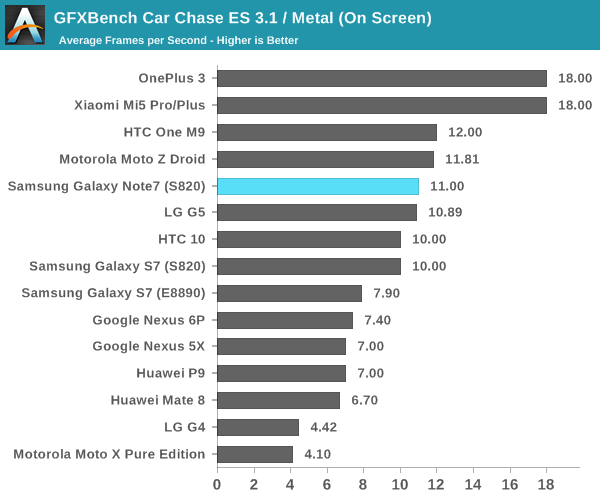
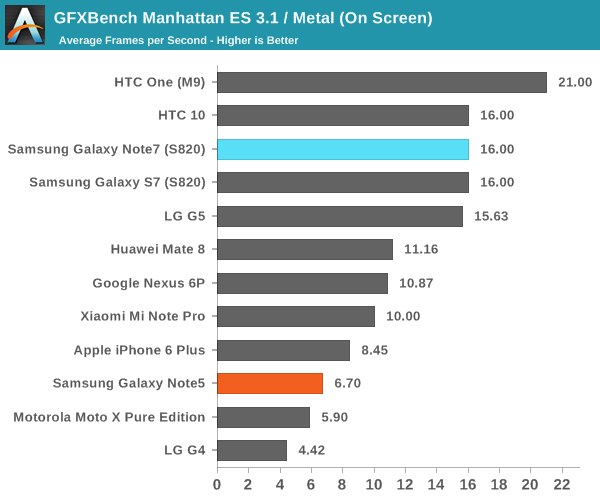
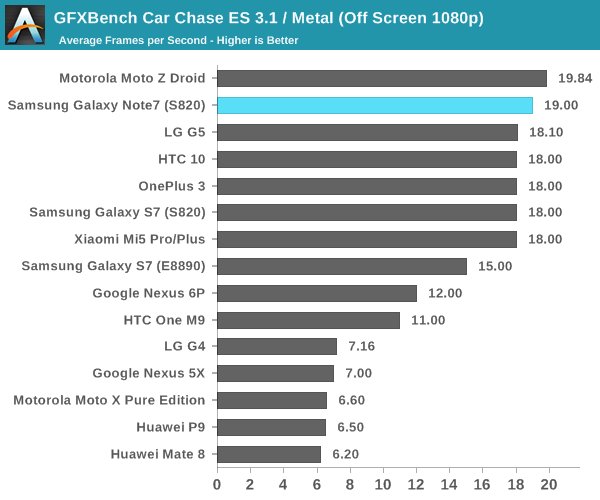
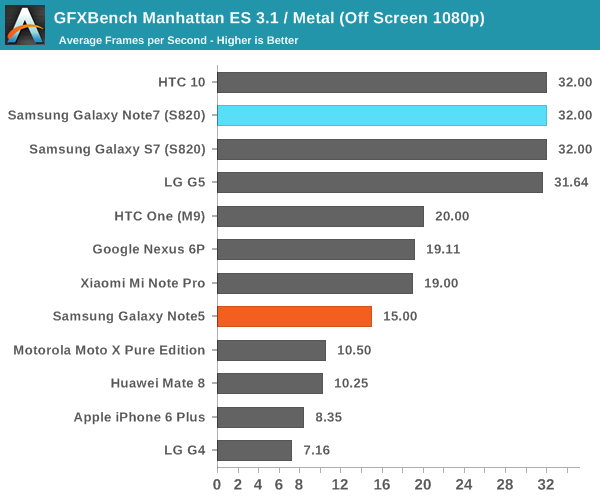

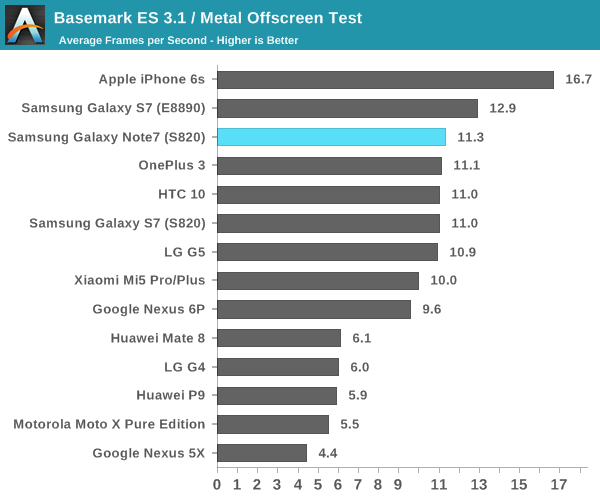
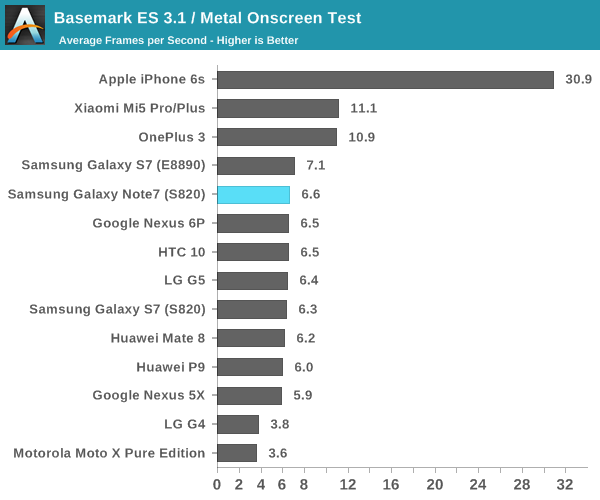
It's probably no surprise, but the Galaxy Note7 performs as expected with the latest drivers and in ideal thermal conditions. The Adreno 530 should be more than sufficient for the forseeable future but for maximum performance it's best to enable 1080p rendering or lower to maximize frame rates in games like Real Racing 3 that tend to really use the GPU to its fullest extent.
NAND Performance
Of course, while Discomark provides a sort of holistic view of performance for a specific task, it’s also important to at least try and break down the various aspects that impact system performance so rather than simple black box testing we can further understand what factors influence performance and therefore provide additional information to make better buying decisions. One of the major contributors to general purpose performance is going to be storage performance, which is often something often ignored by marketing as the nitty gritty details of NAND storage realistically require some background in solid state physics and devices to understand, as well as some understanding of computer science and engineering.
While I’m not really happy with the state of our mobile storage benchmarks, for now I don’t really see another option here as the publicly available storage benchmarks for Android and iOS are fairly basic. Putting aside the state of the benchmarking industry, our current benchmark remains AndroBench 4 which provides at least some basic storage benchmarking capabilities. We use custom settings with this benchmark which attempts to make the test more realistic as the default settings are just wildly unrealistic. This includes adjusting the buffer size, increasing the file size to 100 MB, and only using one thread instead of 8. 256KB file size is targeted as this is the most common block size if you profile this kind of thing for sequential writes and reads, while 4KB block sizes are the most common for other tasks as the vast majority of computer architectures use 4KB pages for virtual memory. Single-threaded I/O is common in most cases because multi-threaded programming is still difficult for most people to reason about in an effective manner because conscious thought is inherently serial in nature with some multiplexing. In addition to this, many eMMC solutions on the market don’t really perform well with multiple threads simultaneously as the controller can’t do anything with extra requests other than reply with a busy signal which already happens with a single thread.
Putting aside discussions of testing we can take a look at the storage solution used in the Galaxy Note7 before getting into the actual results. The Note7 continues to use basically the same storage solution as the Galaxy S7 and S6, which is to say an MLC-based solution that has a UFS Gear 3 single lane interface for bandwidth up to 600 MB/s and basically has the exact same model number if you check the SCSI devices attached to the system save for some changes that indicate the higher 64GB storage relative to the 32GB chips that are most common in the Galaxy S7.
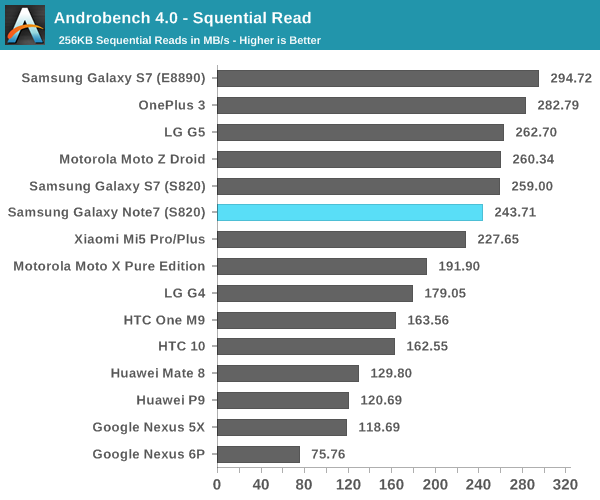

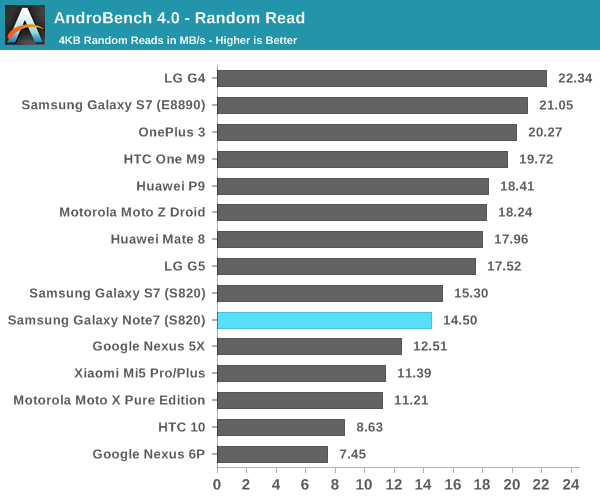
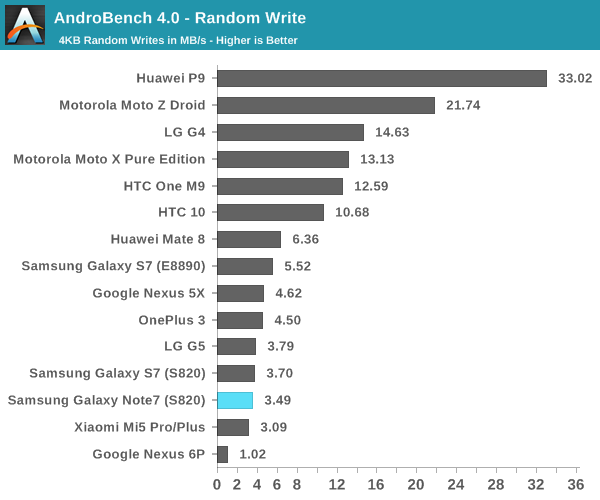
Looking at the test results it performs exactly as quickly as you’d expect from this MLC solution as we’ve tested it in the Galaxy S6, S6 edge, S6 edge+, Note5, S7, S7 edge, and now the Note7 as well as the LG G5. The performance here is acceptable but obviously if you look at burst performance the iPhone 6s has a faster solution due to the hybrid SLC/TLC storage solution. The main benefit of pure MLC NAND is that performance is more consistent as there’s no precipitous drop when the SLC buffer fills. There’s always room to improve but I don’t really see how it’s going to happen unless Samsung moves to V-NAND for the next generation.










202 Comments
View All Comments
Axiomatic - Wednesday, August 17, 2016 - link
My cube mate over the wall from me got the Note 7 today. His immediate comment to me was, "well it performs better with Nova Launcher than Touchwiz."trparky - Wednesday, August 17, 2016 - link
When you have to replace stuff on your phone to get acceptable performance, there's something wrong.silverghozt - Wednesday, August 17, 2016 - link
Are the photos from the Note 7 worse than the Note 5? Can you please compare. I'm astounded that the HTC 10 is taking better images.BoyBawang - Thursday, August 18, 2016 - link
Dear Anandtech,Please do a battery life test of the lower screen resolution settings. If the result is significant, I'll immediately permanently put it to 1080p without second thoughts the moment I have the device. I don't care if the mutant pretenders say that they can distinguish the difference.
thanks
lebigamaca - Thursday, August 18, 2016 - link
It looks like you got the size of the rear camera pixels in reverse. Both are 1/2.6 inch so the 16 megapixel should have smaller pixels than the 12 megapixel.skrewler2 - Thursday, August 18, 2016 - link
it would have been nice to see a picture of the s7 edge and note7 side by side or stacked on top of each other so we could get an idea of how much bigger the note isaryonoco - Friday, August 19, 2016 - link
Does the phone ship with the latest Android Security Patch level?Has the manufacturer committed to providing security patches on a timely basis?
Has the manufacturer committed to providing Android upgrades for X number of year?
Why are such basic questions that affect the usability and viability of a phone ignored by AnandTech? We don't all buy new phones every 6 months. Some of us are holding on to our phones for 24 months or longer. The question "will my phone receive OS updates during its lifetime" is a very valid question that AT pays no attention to.
Similarly we have paragraphs dedicated to the PMIC and various ICs in the phone, paragraphs dedicated to seeing if the phone drops a frame here or there, but no attention paid to the fact that the phone ships with unpatched remote root vulnerabilities.
Anandtech's reviews are becoming less and less relevant. Sure, it's cool to know what IC is doing what in the phone, but it's absolutely irrelevant to its day to day use. Knowing if the OEM is going to supply OS updates and security updates in a timely manner very much matters!
tamalero - Friday, August 19, 2016 - link
As someone who changes cell phones once every 3 or so years.. I'm pissed the current trend of copying Apple and their non changeable battery.Worse when Samsung no longer seems to produce older batteries to force to upgrade.
Not exactly a fan to be forced to for 500+ USD for a throwaway phone.
tamalero - Friday, August 19, 2016 - link
errata.. "not exactly a fan of being forced to FORK 500+ USD for a throaway phone every year"name99 - Friday, August 19, 2016 - link
"Despite all of this, there seems to be a general disappointment with smartphones."Come on Joshua, where do you drag up this nonsense?
There is a tiny fraction of internet whingers, hyperactive fools with the attention-span of 5-year olds and generally the technological to match, that are "disappointed".
Meanwhile in the real world, people are using their phones more than ever --- have you SEEN what a group of public people waiting around (think airport, restaurant, bus) looks like these days?
People in the saturated wealthy nations continue (so far, as of the most recent data) to buy phones on the reliable two-year-update cycle --- and why not? This year's phones are faster than those of two years ago, with more RAM, faster flash, better radios,nicer screens.
Meanwhile people in the non-wealthy world continue to be grateful for the ever falling prices, and enjoy moving on to their first smart phone.
You are not in the business of click-bait or insane interest advocacy; you are in the business of tech journalism. You don't need to write to such stupid sentences; you;re better than that; and the market you're discussing deserves better.
And starting with a stupid premise leads to what are factually flat out factually incorrect statements like "People are increasingly finding it hard to justify phones like the HTC 10 or Galaxy S7 with competition from..."
HOW are people finding it hard to justify phones like the S7? Everyone knows I'm an Apple fan, but I'm also tuned into reality, and the reality is that the S7 has sold pretty damn well, (as far as I can tell perhaps 20% better than the S6).
Look it's probably true that one day we'll hit enough of a wall in phone tech that the upgrade cycle WILL slide, and consumers WILL be massively over-served by phones. But let's not pretend that that prediction has already arrived.
Part of the problem is that these reviews operate with a broken context. It makes sense to compare against last years model, but it also makes sense to compare against the model from two years ago because THAT is where the audience for this product is. Complaining that it won't excite the community it isn't TARGETED AT (ie the owners of last-years model) is just stupid.